 As you look in mid-century cookbooks you see a lot of pineapple recipes. Why was it such a ubiquitous ingredient? Pineapple is identified with Hawaii now but originated in South America. The enzymes in pineapple were once thought to restore digestion and so was hoped to be used as a tonic for the sick. While it is actually high in vitamins particularly C and B vitamins and has lots of fibre, and its enzymes might help gut health it didn’t turn out to be a wonder food in the end. However, that didn’t stop it from becoming a very popular fruit.
As you look in mid-century cookbooks you see a lot of pineapple recipes. Why was it such a ubiquitous ingredient? Pineapple is identified with Hawaii now but originated in South America. The enzymes in pineapple were once thought to restore digestion and so was hoped to be used as a tonic for the sick. While it is actually high in vitamins particularly C and B vitamins and has lots of fibre, and its enzymes might help gut health it didn’t turn out to be a wonder food in the end. However, that didn’t stop it from becoming a very popular fruit.
Pineapples came onto the American market in force in the 1930’s. Most of them were grown in Hawaii where it was discovered the climate was ideal to grow pineapple. The Dole company became the world’s biggest producer and distributor of fresh and canned pineapple by the mid-century. The once rare and exotic fruit suddenly became plentiful on the supermarket shelves. The 1950’s became a decade of pineapple obsession.
As well this was a time of fascination with Hawaii and the South Seas. Palm trees, colourful aloha shirts and dresses, surfing, tiki torches, luaus and pineapple were often motifs found in homes or at dinner parties. The exotic images of the Hawaiian islands were found in many ads too.
It also turns out that pineapple is a pretty adaptable fruit. Many of the recipes are for salads and desserts. But some of the recipes are savoury and may be a bit odd for our modern tastebuds, or at least mine. And note that you cannot just substitute fresh pineapple for canned in all recipes as the bromolain in fresh pineapple will break down the proteins in jello for example and ruin the dish. This might be a case to be made for using it with meat, however.
Let’s start with another classic pineapple upside down cake. In my earlier post I gave you the quick and easy version that uses a cake mix. Here is a different recipe from 1955 and this is one from scratch.
 Pineapple Upside-Down Cake From Scratch
Pineapple Upside-Down Cake From Scratch
Ingredients:
1/2 cup butter
1 cup brown sugar
1 No. 2 can of sliced pineapple (a 20 0z can)
2 Tablespoons pecans
1 cup cake flour
1 teaspoon baking powder
1/8 teaspoon salt
3 eggs separated
1 cup sugar
5 Tablespoons of pineapple juice
Directions:
Melt butter in large baking pan. Spread brown sugar evenly in the pan and arrange the pineapple slices on the sugar. Fill empty spaces with pecans. Mix flour, baking powder and salt together. Beat egg yolks until light , add sugar gradually; add in pineapple juice and flour; fold in stiffly beaten egg whites. Pour the batter over the pineapple. Bake at 375 degrees for 30 to 35 minutes. Let sit for a few minutes before turning the cake out onto a plate. Serve with whipped cream . Serves 8.
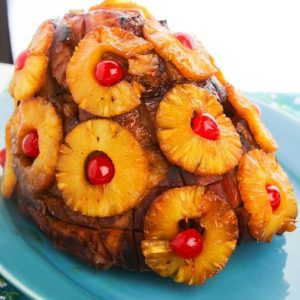 Pineapple covered ham was a true crowd-pleaser at any Sunday dinner mid-century. There are a number of different variations out there but a common one, and one my mother liked used cloves, pineapple rings and sometimes maraschino cherries. It is remarkably easy to make.
Pineapple covered ham was a true crowd-pleaser at any Sunday dinner mid-century. There are a number of different variations out there but a common one, and one my mother liked used cloves, pineapple rings and sometimes maraschino cherries. It is remarkably easy to make.
Start with a fully cooked boneless ham and bake it until it is heated all the way through following the directions on the ham. Score the skin of the ham or cut slices part way through to allow the glaze and juices to get into the ham. Use the cloves to hold the pineapple ring to the ham. Use toothpicks to hold the cherries to the ham. Then you add the glaze.
The glaze is the important part of this recipe.
Combine in a bowl:
1 cup of brown sugar
2 Tablespoons of Dijon mustard
then begin adding pineapple juice from the can a bit at a time, stirring until you have a thick glaze like a syrup.
Spoon the glaze all over the ham until thoroughly covered. Return the ham to the oven and bake another 30 minutes. Remove from the oven and spoon any glaze left in the dish back over the ham and serve. Wait for the oohs and aahs! This part is important- remind everyone to mind the toothpicks and cloves, I still remember chomping down and getting the strong taste of roasted cloves instead of ham.
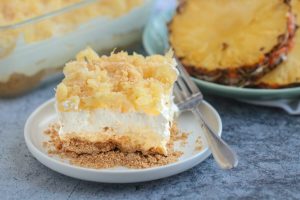 Here is another pineapple recipe a kind of light fluffy dessert sometimes called ambrosia, I believe, that I remember from childhood too, this particular recipe is from 1968.
Here is another pineapple recipe a kind of light fluffy dessert sometimes called ambrosia, I believe, that I remember from childhood too, this particular recipe is from 1968.
Pineapple Delight
Ingredients:
1 1/2 cup icing sugar
1/2 cup soft butter
2 eggs beaten
1/2 pint heavy cream, whipped
24 graham crackers, crushed
1 20 oz can crushed pineapple
Directions:
Cream together sugar and butter, add eggs one at a time and beat. Place layer this of graham cracker crumbs in the bottom of an 9 x 12 pan. Spread the sugar and butter mixture over the crumbs. Then spread the whipped cream over the crumbs. Add a layer of drained pineapple. Add one more layer of cracker crumbs. Chill in fridge for 12 hours or longer. Cut and serve.
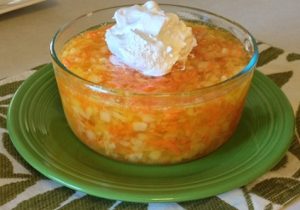
Jellied pineapple salads, all kinds of them embraced two mid-century crazes at once pineapple and jello. While jellied salads and even jello are not everyone’s favourite today they were popular mid-century. I think one of the reasons was they looked cool straight out of the mould and packed a lot of flavour in a small dish.
The Pineapple jellied salad below is a recipe that my mother made for many holiday dinners. The vegetables and fruit she used got changed up over the years.
Pineapple Jelly Salad
1 pkg lemon or lime Jello
1 1/2 cup boiling water
2 Tablespoons of lemon juice
Mix these together and put it in the fridge to set slightly until it is shaky. Then add:
1 cup drained crushed pineapple
1/2 cup diced cucumbers
1/2 cup shredded carrots
Beat together until well mixed. Chill for several hours until fully set. Add whipped cream as topping.
One of the kinds of recipe books I like best are the vintage collections of community or church of real women’s favourite, tried and true recipes. A simple salad that comes from a real housewife from 1958, Five Cup Salad, is an easy “dump salad”.
Five Cup Salad
Ingredients:
1 cup of dried coconut
1 cup mandarin orange pieces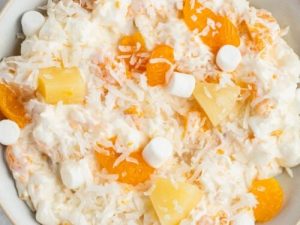
1 cup pineapple tidbits drained
1 cup sour cream
Directions:
Combine, stir well and refrigerate for several hours. You might put whipped cream on top.
A few of the vintage recipes I have seen for cakes or cookies call for pineapple marmalade or jam. It turns out this is very easy to make. It’s just pineapple and sugar in a ratio of 1 cup of crushed pineapple with juice to 3/4 of a cup of sugar. Boil until thickened and bottle it. Nothing else is needed.
A little cookbook published in Hawaii about Hawaiian fruit recipes has a great one for Pineapple Chutney. I always like the idea of serving chutney on chicken. The recipe is:
Pineapple Chutney
2 ounces of pepper
1 oz of garlic
3 pounds of pineapple
1 Tablespoons of ginger
1 1/2 pounds of brown sugar
1 1/2 pints of vinegar
1/2 pound raisins
1/2 pound almonds
1 Tbsp of salt
Directions:
Cook the pineapple, vinegar and salt. Chop nuts, raisins, garlic and pepper up finely and add to pineapple mixture. If the mixture is very juicy you might need to boil the mixture down to thicken.
My handy 1955 Good Housekeeping Magazine offers a savoury recipe in an ad for Del Monte canned pineapple. The recipe was for pineapple glazed spareribs.
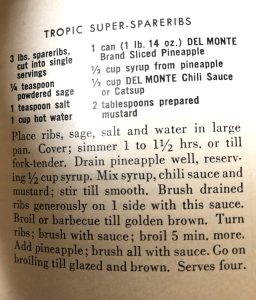

In my browsing of other ads from the era I have seen other savoury pineapple dishes. One suggested topping a pork meatloaf with pineapple. Another suggested topping pork chops with pineapple before baking them. I have also seen pineapple used in sweet and sour meatballs too. You could create a pineapple marinade for chicken breasts. Sometimes they put a pineapple ring on a burger. I am not so sure about how much the pineapple would enhance the meat dishes. Although using pineapple jam would work as an easy glaze. I do like pineapple on pizzas but we won’t go into that controversial discussion right now.
Enjoy some pineapple today!
